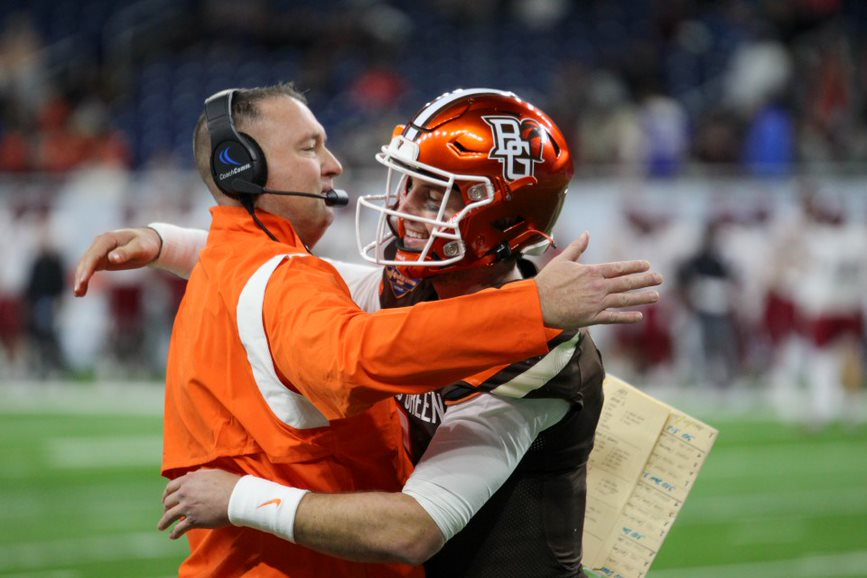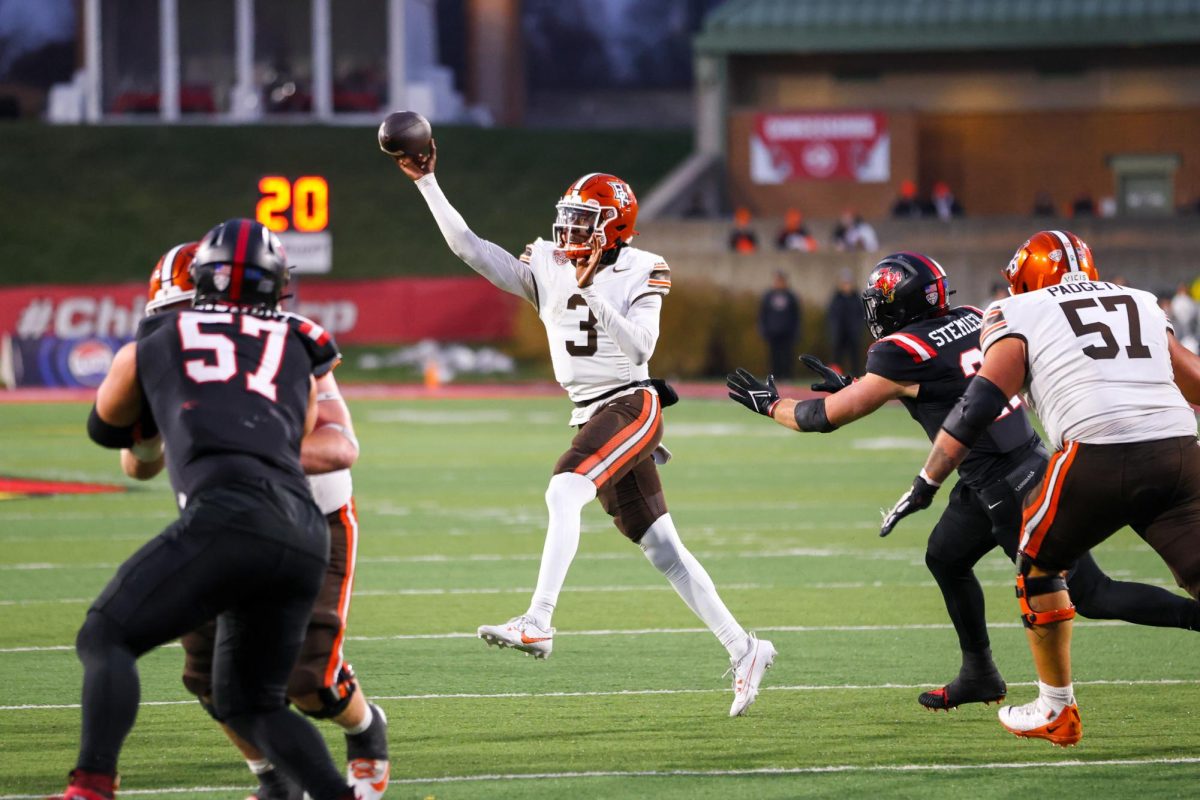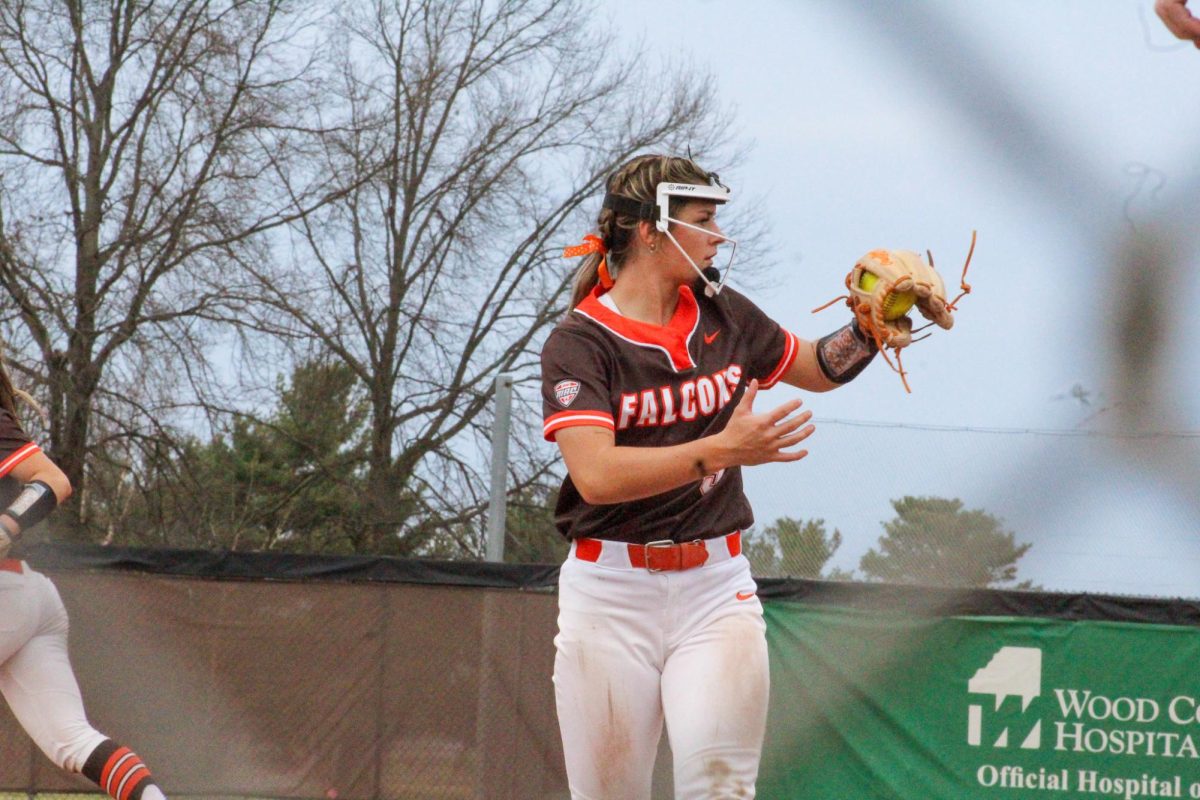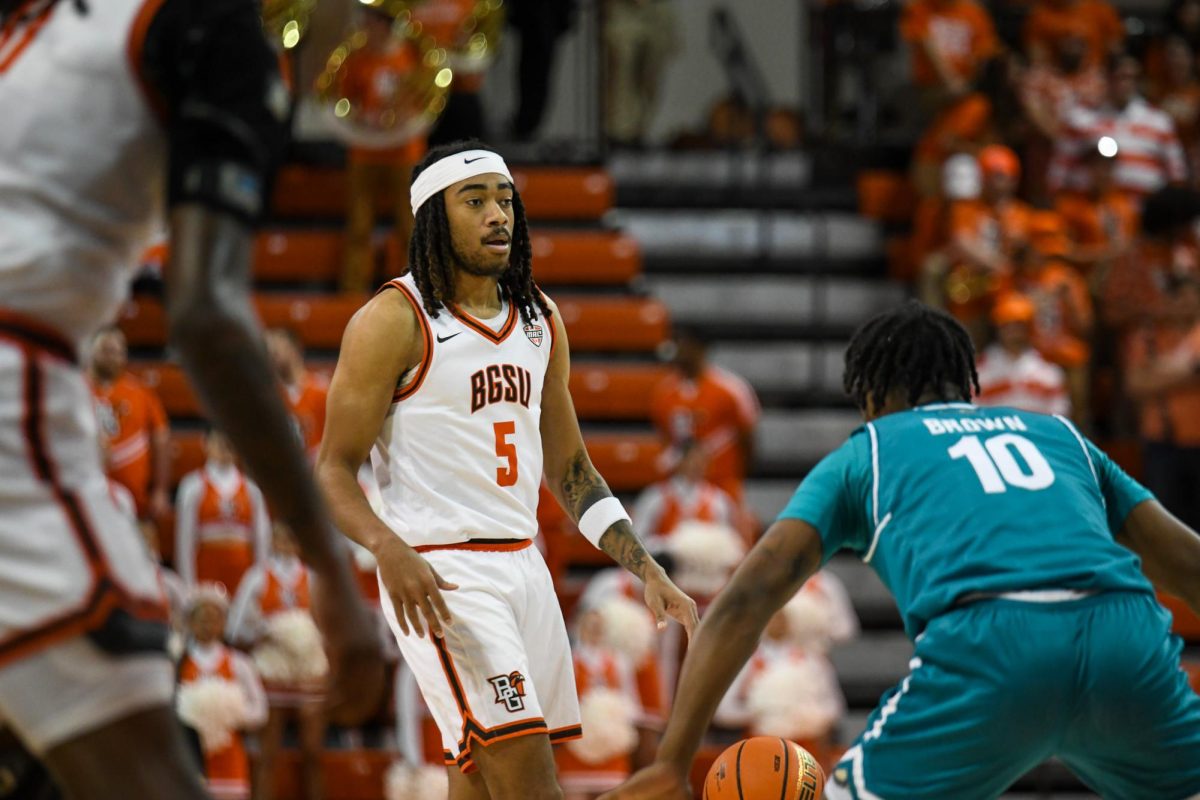Should BGSU give Scot Loeffler a contract extension?
February 8, 2023
If you were told the head coach of a college football team had compiled an overall record of 13-29, a conference record of 9-20, and was responsible for the worst three-season stretch in program history based on winning percentage, you would certainly not advocate for that coach to receive a contract extension.
While all three of those statistics belong to Scot Loeffler, the answer and decision for whether the BGSU football coach should receive a contract extension is not as simple, but rather more complex than it may seem on the surface.
Before evaluating the performance of Loeffler during his four seasons at the helm of Bowling Green’s football program, it is first necessary to look back at what happened before he took over in 2019 and to understand what the state of the program was when he was hired.
From 2013-2015, Dave Clawson and Dino Babers led the Falcons to three straight Mid-American Conference East titles, including MAC Championships in 2013 and 2015. After Babers left to become the new head coach for Syracuse, Mike Jinks was chosen as his successor.
Instead of continuing the Orange and Browns’ winning ways, Jinks proceeded to do the opposite.
He did not win another MAC East title. In fact, he never came close, as he instead proceeded to run the program into the ground.
From 2016-2018, BGSU had an overall record of 9-27 and a conference record of 7-17. Jinks took over a program that had made the MAC Championship game three years in a row and was fired after leading the team to its second-worst three-season stretch in program history based on winning percentage.
When Loeffler was hired on Nov. 28, 2018, he inherited one of the nation’s most significant rebuilding projects and, frankly, a dumpster fire of a program that was a mere shell of what it had been four years prior. Loeffler planned to revitalize the program to regain its winning ways and build it to a position where it could sustain that success.
After four years filled with ups and downs in every aspect of the program, Loeffler only has one year remaining on his current contract. Going into what inevitably seems like a make-or-break season next fall, it is essential to thoroughly evaluate all aspects of his performance over the past four years before deciding whether he is the right person to continue rebuilding and developing the BGSU football program.
Recruiting
Recruiting is one of the most important aspects of college football. When programs have consistently good recruiting, they tend to win. When programs have consistently bad recruiting, they tend to lose.
For BGSU, three failed recruiting classes with Jinks at the helm dug the program into its biggest hole and created the toughest challenge in Loeffler’s coaching career.
On the surface, Loeffler’s predecessor did a good job recruiting during his three years at BG. However, once you dig a little deeper, you see crystal clear why the program took a nosedive under the leadership of Jinks.
In his three years at BGSU, Jinks had the fifth, second and third-best recruiting classes in 2016, 2017 and 2018, respectively. Jinks recruited the seventh most commits and third most three-star commits in the MAC during that span.
Jinks however did not have strong connections in Ohio. His strong connections and pipeline were in Texas, where he was a longtime high school coach and an assistant coach at Texas Tech.
At the time Jinks was hired by BG, he only had three years of college coaching experience, all at Texas Tech and none at the coordinator level. On top of that, Jinks had never recruited in Ohio.
Even though Jinks recruited very good classes, he did not build the program’s foundation around recruits from the Midwest. This is precisely what Loeffler, an Ohioan who had recruited in the Midwest for years, planned to do differently to rebuild the foundation of the program and turn it around.
Just as Rome was not built in a day, Loeffler’s plan to change the course of the football program at BG through recruiting would take time. Loeffler knew from the start that rebuilding the program’s foundation with his plan would take time.
“I’m not going to use Bowling Green and quick fix it overnight and leave like other people have in the past here. We’re going to get this thing that is sustained, we’re going to get this thing right, and the fact of the matter is that it is going to take time,” Loeffler said in a virtual press conference on Nov. 12, 2020. “If I was walking into something that was right, there are no excuses. But this thing is not right, and it hasn’t been right, and we’re going to get it right, plain and simple.”
Loeffler’s first recruiting class in 2019 was a dud, the worst class in the MAC. However, his next class in 2020 was the complete opposite, the second-best in the conference.
Even after a great recruiting class, Loeffler’s Falcons were still trying to rebuild the foundation that Jinks had obliterated.
“No one in the ’17, ’18 or ’19 class are here, ’17 and ’18 in particular. So, we’re going to build this thing that Bowling Green can sustain,” Loeffler said in 2020. “Here’s the fact of the matter. There was no foundation and no base. Zero. Look at our roster. There is no one from Ohio. There is no one from Michigan. There is no one from Illinois.”
His next three recruiting classes, however, were nothing special. All three ranked in the bottom four of the MAC, including the latest 2023 class, which ranked second to last in the conference.
So, how good has Loeffler’s performance been through five recruiting classes at BGSU? The answer is not great, but also not terrible.
Overall, he has done an average job with recruiting, resulting in the program’s slow development and rebuilding process.
Through five recruiting classes at BG, the Falcons have the seventh most commits but the fourth fewest three-star commits in the MAC during that span.
Transfer Portal
While recruiting is still the most important aspect of college football, the transfer portal may be the sport’s future. Like recruiting, Loeffler’s performance with the transfer portal has been average at best.
Since 2019, BGSU has added 21 total and 15 three-star players in the transfer portal, ranking fifth in the MAC during that time. BG is also one of six teams in the MAC since 2019 to add a four-star transfer.
Loeffler’s ability to add talent through the transfer portal has not been a strength, but at the same time, it has not been the problem. The problem for the Falcons has been the talent they have lost through the portal under Loeffler.
A few weeks ago, Loeffler and the Falcons netted their best acquisition through the portal in the past four years, adding four-star quarterback Connor Bazelak, the former Indiana starter. While that was a significant pickup, the Falcons also lost two four-star and four three-star players in the transfer portal this year.
Under Loeffler, BG has lost 29 total players and 17 three-star players in the portal, ranking second and fourth most in the MAC during that period. The Falcons are also one of five teams in the MAC that have lost multiple four-star players since 2019.
Although Loeffler has added a decent amount of talent through the transfer portal since he arrived at Bowling Green, the Falcons have lost more talent than almost every other MAC team in the portal since 2019.
Best and Worst Moments in the Loeffler Era (up to this point)
Good performances with recruiting and the transfer portal are essential, but the be-all and end-all are the performances on the field and the results in the win-loss column.
While there have been some memorable performances by Loeffler-led BG teams, there have been many more forgettable moments.
The Loeffler era started with a bang in week one of the 2019 season. BGSU dominated Morgan State in every aspect of the game, defeating them 46-3 at the Doyt. The Falcons outgained the Bears in total yards 627-70, giving Loeffler his first Bowling Green win emphatically.
However, for the rest of his first season at BGSU, the Falcons struggled to fly as high as they did in the first week. The Orange and Brown would only be able to win two more games the rest of the season, as they would finish 3-9.
Although they only had three wins in 2019, BG did something in week six that they had not been able to do since 2009: beat Toledo. Loeffler ended Bowling Green’s nine-season losing streak against their archrival Toledo, winning 20-7.
And yet, despite earning his first signature win at BGSU by winning the Battle of I-75 for the first time in almost a decade, Loeffler suffered many humiliating losses in his first season with the Orange and Brown.
The Falcons gave up at least 40 points in seven games during the 2019 season, all of which resulted in losses. The worst were two 52-0 shutout losses against Kansas State and Notre Dame, a 62-20 defeat against conference rival Kent State and a 66-24 loss against Ohio.
Loeffler’s second season with BG, the 2020 pandemic-shortened five-game season, was ugly. He was unable to guide the Falcons to a win, getting blown out in every game and finishing the season 0-5.
The Orange and Brown lost the Battle of I-75 to Toledo, 38-3. They were then blown out by Kent State, Buffalo and Ohio, losing those games 62-24, 42-17 and 52-10, respectively. The nightmare season ended as BG became the only team to lose to Akron that season, falling 31-3 and finishing the season with an embarrassing 0-5 record.
In 2021, the Falcons struggled for a third straight season under Loeffler. BGSU finished with a pedestrian 4-8 record, capping the worst three-season stretch in program history by winning percentage.
BGSU was blown out by Toledo for a second straight season, losing 49-17. They also lost to the Zips for the second year in a row, losing 35-20 to an Akron team that only won two games that year.
Although the Falcons finished with another losing record in 2021, Loeffler led the Falcons to one of the program’s biggest upsets. The Orange and Brown traveled to Minnesota as a 30.5-point underdog and shocked the Golden Gophers, winning 14-10.
BGSU’s latest season, 2022, was by far Loeffler’s most successful with the Orange and Brown. He led the Falcons to a 6-7 record and their first bowl game appearance since 2015.
On top of making his first bowl game with BGSU, Loeffler added some signature wins to his resume in 2022.
During homecoming weekend, Loeffler led the Falcons to a 34-31 victory over Marshall, who were coming off a win against Notre Dame, who were ranked eighth in the country. Loeffler also beat Toledo for the second time in his four years at Bowling Green, winning the Battle of I-75, 42-35.
While Loeffler had his best season at BGSU, there were still some ugly moments for the Falcons. The worst was undoubtedly the loss against Eastern Kentucky. BG paid EKU, an FCS opponent, $350,000 to face them and went on to lose in seven overtimes, 59-57.
Team Progression Under Loeffler (Offensive and Defensive)
Like Bowling Green’s record under Loeffler, the Falcons’ offense and defense have slowly progressed over the past four years in most aspects. But, how much have the offense and defense progressed during the Loeffler era?
When Loeffler was named head coach at BG, he wanted a physical defense that limited big plays.
“We want to be a fast, aggressive, hard-core defense that’s stingy and that doesn’t give up big plays, that can stop the run,” Loeffler said on the BGSU Ziggycast on Nov. 29, 2018. “We’re always looking for a physical, fast, relentless, aggressive defense that doesn’t give up big plays. That’s the challenge. You can’t give up big plays.”
In 2019, Loeffler’s defense was none of those things. During his first season leading the Falcons, his defense gave up 38.6 points per game, 467.2 yards per game and 7.0 yards per play. BG had two sacks per game and just over one turnover per game, as opponents converted on almost 45% of their third-down attempts.
Fast forward a few years, and Loeffler’s defense has improved in nearly every aspect.
Compared to his first season leading the Falcons, Loeffler’s defense allowed 6.1 fewer points per game, almost 50 fewer yards per game and just over one less yard per play. Loeffler’s defense also had more sacks and turnovers per game in 2022 than in 2019, but opponents also converted more on third downs.
While the Falcons’ defense has improved in almost every aspect during Loeffler’s tenure as head coach, the rushing defense has stood out.
In 2019, the Falcons gave up 242.8 rushing yards per game and 5.8 rushing yards per attempt. In 2022, Loeffler’s Falcons gave up 168.9 rushing yards per game and 4.4 rushing yards per attempt.
Four years later, Loeffler’s defense has become some of what he envisioned. BG’s defense has improved in almost every aspect, but it still could use improvement in many areas. Loeffler’s defense has gotten faster and more aggressive over his four years, but this past season they still missed a lot of tackles and gave up big plays in critical moments multiple times.
BGSU’s offense under Loeffler has been similar to the defense in that it has progressed over the past four years but still has a lot of room for improvement.
Going into his first season at BG, Loeffler envisioned an explosive offense.
“Our brand of football will be simple. It will be intertwined with great defense, great special teams and a physical, explosive offense,” Loeffler said during his introductory press conference on Nov. 29, 2018.
In the 2019 season, the Falcons’ offense was anything but explosive. The Orange and Brown gained 319.8 yards per game and 4.6 yards per play, scoring just 16 points per game.
During the 2022 season, those numbers increased to 334.8 yards per game and 5.1 yards per play, scoring 23.5 points per game. Although the offense overall improved over four years under Loeffler, the rushing offense got worse almost every season.
Excluding the 2020 pandemic season, the Falcons’ total rushing yards and rushing yards per play decreased every season. In 2019, BG rushed for 162.5 yards per game and 3.9 yards per play, but in 2022 they ran for just 100.2 yards per game and 3.1 yards per attempt.
Although the rushing offense has gotten worse under Loeffler, that fact of the matter is that has never been his strong suit. Loeffler’s forte and expertise have always been coaching and developing quarterbacks.
Before arriving at Bowling Green, Loeffler was a quarterbacks coach at Central Michigan, Michigan, Florida, Temple, Auburn, Virginia Tech and Boston College. He was also a quarterback coach in the NFL with the Detroit Lions for one season.
He has coached seven quarterbacks that have gone on to play in the NFL. These include Tom Brady, Tim Tebow, Brian Griese, Chad Henne, Drew Henson, John Navarre and Logan Thomas.
Loeffler has proved his pedigree of developing and coaching quarterbacks through one of his best, yet least talked about accomplishments over the past four years with BG: the development of Matt McDonald.
McDonald followed Loeffler from Boston College to BGSU in 2019. McDonald was forced to sit out the 2019 season due to eligibility issues but went on to be the starter for the next three seasons.
Over his three seasons playing for BG, McDonald improved in every statistical category season-to-season. A lot of his positive progression can be attributed to the coaching of Loeffler.
McDonald got off to about as bad a start a quarterback can have with a new team during his first season, the Covid-shortened 2020 season. In five games, McDonald completed just 43.9% of his passes for 712 yards, 5.8 yards per attempt, 3.8 air yards per attempt, one touchdown and six interceptions, for an ugly passing efficiency rating of 85.5.
Over the next two seasons, Loeffler turned that same quarterback into one of the better starters in the MAC his senior year. After a horrendous start to his career as a Falcon, McDonald, in his senior year with BG, completed 61.2% of his passes for 2,639 yards, 7.0 yards per attempt, 7.1 air yards per attempt, 22 touchdowns, nine interceptions and a passing efficiency rating of 134.1.
In his four years, Loeffler has proved once again what everyone already knew about him when he arrived at Bowling Green in 2018:
He can develop quarterbacks.
That said, his team’s performance on both sides of the ball throughout the past four years has improved but left a lot to be desired on the field, leaving Loeffler with more to prove.
Verdict
Four years into the Loeffler era, BGSU is in a much better position than they were when Jinks was fired in 2018. However, the goal was never to get back to average, which is where the Falcons sit now. The goal was always to build the program back up to the level of success where the team could consistently compete for MAC Championships.
Loeffler knows that even though this past season was a significant improvement over the previous six, having a 6-6 record during the regular season is not the goal.
“They’ve won here, and there has just been a little bit of a bump in the road. It’s no one’s fault. Things happen in football sometimes that get crazy. But our job is just to get over that bump and get back into the standards and expectations that this place deserves,” Loeffler said during his introductory press conference on Nov. 29, 2018. “I’m so excited about having the opportunity to be at a place where winning is important, and every place I’ve been a part of, it’s been that way. Winning is important. You don’t want to go to a place where 6-6 is ok.”
During this past season, the Falcons showed signs that Loeffler may have finally gotten the program on the other side of the bump. However, Loeffler’s performance throughout the past four years and the program’s future are still very much up in the air.
If Loeffler wants to be the man in charge for the foreseeable future and finish the rebuild of this program from a dumpster fire to a team that consistently competes in bowl games and MAC Championships, his performance needs to improve in multiple areas.
His performance with recruiting and the transfer portal needs to improve if the program is going to take another step and get closer to the next level of success.
Continuing to be in the middle of the pack in your conference regarding recruiting and adding players through the transfer portal will never lead to a consistently successful program. It is hard, and almost impossible, to have a football program that consistently wins when your recruiting is consistently in the bottom half of the conference, and your performance in the transfer portal is average at best.
Loeffler also needs to show consistency in terms of results on the field if he wants to earn a contract extension at BGSU. Through four seasons, Loeffler’s tenure at BGSU has been like a roller coaster at Cedar Point, filled with ups and downs, highs and lows.
Although there have been many more lows than highs for Loeffler, the 2022 season was a massive improvement from the three previous seasons. The results next season will be the gavel that will lead to the final judgement of Loeffler.
Before we see those results, there is no way BGSU, and new athletic director Derek van der Merwe can justify giving Loeffler an extension.
With how pitiful the program has been since 2016, one bowl game appearance should not warrant a contract extension for a coach with a 13-29 overall record in four seasons. Giving Loeffler an extension before next season plays out would be foolish and present too much risk for the future of the program.
For Loeffler to earn a contract extension, he must prove he is the guy. He needs to prove that to van der Merwe, the university and the fans that they can trust him to take this program to the next level.
To do this, he needs this upcoming season to garner results that are level or better than this past season.
If Loeffler cannot demonstrate that he has gotten the team over the proverbial ‘bump in the road,’ BGSU will need to part ways and find a coach that can finish the rebuild and take the program to the next level.
For more information about Loeffler, visit the athletics webpage.













